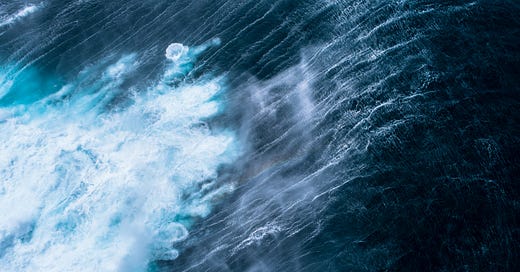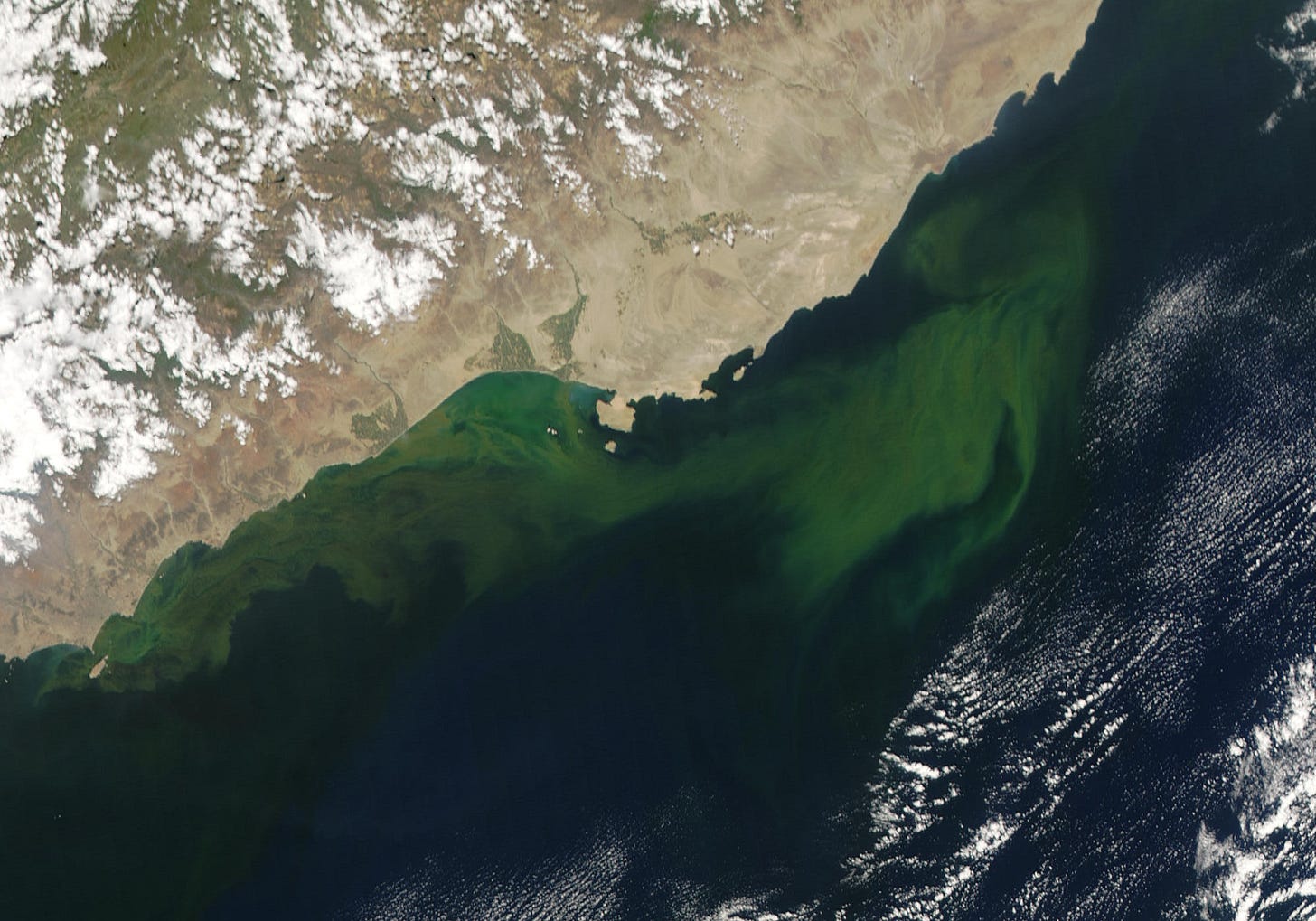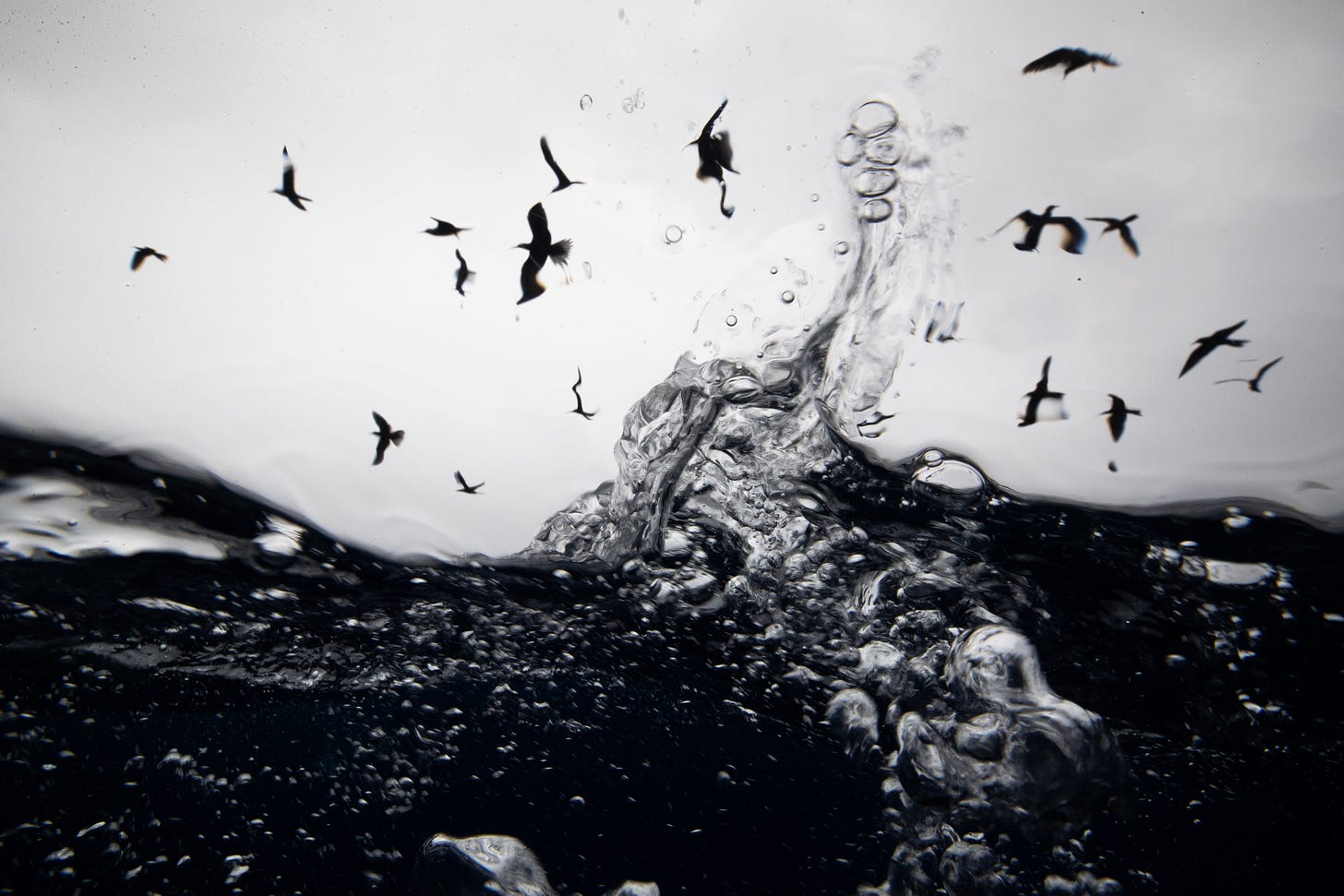Welcome to another edition of Deep Dives by Beached - an in-depth exploration of everything oceanic, from scientific discoveries to marine mysteries.
Expect a bit of history, science and adventure, as we dive deep into the big blue 🤿
We don't often give much thought to the purpose of wind1, but across the global ocean it’s hard at work enabling a fundamental process known as upwelling.
In simple terms, upwelling occurs when the wind displaces surface water and cold, nutrient-rich water from below ‘wells up’ to replace it. But this seemingly inconsequential process actually has far-reaching benefits for marine life and ocean ecosystems.
It turns out not all seawater is created equal. The deep waters that rise to the surface are much more dense and cooler than water at the surface because they’re out of reach of sunlight. They are also rich in nutrients (thanks to the decomposition of sinking organic matter), more acidic and less oxygenated. And so, as this deep-sea buffet rises to the top and is exposed to sunlight, biological activity goes wild.
The nutrient-rich upwelled water acts as a fertiliser, stimulating the growth and reproduction of primary producers2 such as phytoplankton. These microscopic marine plants form the base of the oceanic food web, supporting an abundance of life. In fact, upwelling regions are so productive that despite occupying a mere 5% of the total ocean area, they account for a whopping 25% of global marine fish catches. The impact of primary producers on the ocean community is so heavily felt that in years when upwelling has occurred at noticeably lower rates than normal there has been an increase in mortality rates of seabirds and surface-level consumers due to a lack of food in the ecosystem.
But how does it actually work?
It’s all down to Earth’s rotation. As the earth rotates on its axis from west to east this causes winds to veer right in the northern hemisphere and left in the southern hemisphere – a process known as the Coriolis effect. This effect is largely responsible for upwelling in coastal regions but also in the open ocean around the equator as trade winds at the equator blow surface water in opposite directions, allowing for even deeper water to rise up.
Upwelling is so impactful that it can even weaken cyclones. Wind patterns of slow-moving cyclones can blow surface water aside causing upwelling directly beneath the centre of the cyclone (or eye of the storm), which gives rise to colder water, effectively slowing the cyclone down.
The effects of upwelling are so pronounced that scientists can even identify strong upwelling zones from space. The combination of cool sea surface temperatures and high concentrations of chlorophyll-a (a telltale sign of phytoplankton) create distinct patterns visible to satellite sensors.
And coastal upwelling?
While upwelling occurs across the open ocean, it's along coastlines where this process is most impactful. Coastal environments, particularly bays, are ideal locations for upwelling. Here, strong winds blow parallel to the coastline and, working in tandem with the Coriolis effect, push surface waters away from the shore for deep water to then rise up and replace it.
These coastal upwelling zones are remarkably productive marine ecosystems as the constant influx of nutrients creates exceptionally fertile waters. Here, phytoplankton thrive, providing a wealth of food to support populations of marine mammals and seabirds often found in these areas.
And downwelling?
As is to be expected this is the exact opposite of upwelling. This reverse process occurs when the wind shifts surface water towards the coastline where it builds up and eventually sinks to the bottom. Upwelling and downwelling often alternate seasonally. Some coastal regions will see upwelling throughout summer and downwelling in winter when the winds have changed direction.
The benefits
For many marine creatures, upwelling (and downwelling) is a blessing, but it can sweep tiny, fragile larvae – the developing forms of many fish and invertebrates — far offshore, potentially endangering their survival. However, the same surge of upwelling can also support biodiversity by dispersing species across wide areas in the exact same way. The process affects conditions out of the ocean too. As cold water rises to the surface, it cools the air above, often leading to the formation of sea fog around coastal areas.
But perhaps upwelling's most significant impact is on marine productivity. The nutrient-rich waters it brings to the surface support prolific growth of seaweed and plankton. These, in turn, form the foundation of complex food webs, sustaining diverse populations of fish, marine mammals, and seabirds. It's no exaggeration to say that upwelling generates some of the most fertile marine ecosystems in the world, flipping things upside down so animals living at the surface can receive the benefits of the deep ocean and vice-versa.
Climate change
Impactful though upwelling may be, it is not immune to the effects of climate change.
Ocean warming, acidification, and deoxygenation, in combination, have the potential to disrupt these types of natural phenomena and thus the functioning of entire ecosystems. Less food in areas that are known to marine species as hotspots for feeding could lead to the breakdown of an entire ecosystem and a great loss of biodiversity. Significant changes to ecosystem services that are extremely important to humans are also to be expected. Who knows what the consequences of that will be.
So, although upwelling may start with a simple gust of wind, its invisible presence across the ocean is imperative. From feeding tiny plankton to supporting global fisheries, it is a significant piece in a much larger puzzle which keeps our planet functioning at full health.
Here at Beached we are building a community that can put our brains and resources together to highlight and fund solutions to the problems facing the ocean and its inhabitants. I hope you’ll join our humble community and click subscribe for free or support our work by purchasing the paid subscription.
All Beached posts are free to read but if you can we ask you to support our work through a paid subscription. These directly support the work of Beached and allow us to engage in more conversations with experts in the field of marine conservation and spend more time researching a wider breadth of topics for the newsletters. Paid subscriptions allow us to dedicate more time and effort to creating a community and provide the space for stakeholders to come together, stay abreast of each other’s work and foster improved collaboration and coordination.
One day Beached hope to donate a large percentage of the revenue from paid subscriptions to marine conservation organisations and charities to support their work too. Working together, we can reverse the degradation of our oceans.
Amie 🐋
other than when I’m cursing it for blowing me off balance on a hike.
Primary producers are organisms capable of producing chemical energy in organic compounds through processes like photosynthesis.








Great article! Upwelling is significant in western boundary currents, so places like California and Peru, leading to huge amounts of biomass in these regions.
Another note on climate change - corals and kelps get killed off by high water temperatures as they are essentially running a fever. Areas of high upwelling, either through wind-driven coastal upwelling or high energy internal wave regions, can act as a buffer to this by periodically cooling the organisms down. How this evolves with changes to the ocean over time is vital for understanding where organisms will be able to survive in the coming decades.
Thank you, there is a lot of information packed in here and the article about the Coriolis effect was also very informative. I appreciate the Deep Dive!